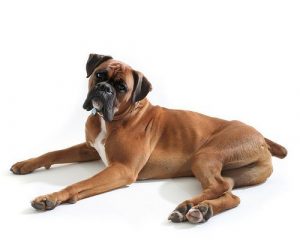Breed History
The Boxer is descended from German Bullenbeiszer and the Barenbeiszer dogs. This breed was developed in the 1800s. These mastiff-type dogs were later crossed with the powerful  ancestors of the Bulldog and Mastiff. Early Boxers were used as cattle dogs to help round up livestock and catch wild boar and bison until the hunters could arrive. Boxers have talents in being a watchdog, guarding, police work, military work, search and rescue and competitive obedience. There are two distinct types of Boxers – the German Boxer and the American Boxer. German Boxers are generally more muscular than their American counterparts.
ancestors of the Bulldog and Mastiff. Early Boxers were used as cattle dogs to help round up livestock and catch wild boar and bison until the hunters could arrive. Boxers have talents in being a watchdog, guarding, police work, military work, search and rescue and competitive obedience. There are two distinct types of Boxers – the German Boxer and the American Boxer. German Boxers are generally more muscular than their American counterparts.
Breed Description
Boxers usually weight between 60 and 70 pounds and are 22 to 25 inches high. The body is compact and muscular. The muzzle is short and blunt. The eyes are dark brown and ears are set high on the head. Boxer tails are usually docked. The AKC penalizes a natural tail while Europe has outlawed the cutting of the tail. Coats are short and smooth and come in fawn, brindle, tan, mahogany and black. They often have white markings. Occasionally a Boxer has a white coat, which is frowned upon by dog clubs (however they are awfully cute). They can live as long as 11 years. Litter size can be from three to eight puppies, although the most common average is six.
Personality
This is a happy, high spirited breed and tends to be playful, curious and energetic. They are highly intelligent and are eager to learn. They are loyal and affectionate and are known for the way they get along so well with children. They get along well with other animals, but rodents, birds and chickens may be too tempting for them to be left alone with. Boxers use their front paws the way a cat would – pawing at their food bowls and toys. Training should start young and be positive and consistent.
<Read Top Reason Why To Train With Positive Reinforcement>
Ideal human companions for a Boxer are a family, active outdoorsy single and a-type personalities. They have been used as service and guide dogs for the blind, police dogs in K9 units, and therapy dogs.
Photo: Courtesy of jlhopgood via Flickr (CC BY-ND 2.0)









